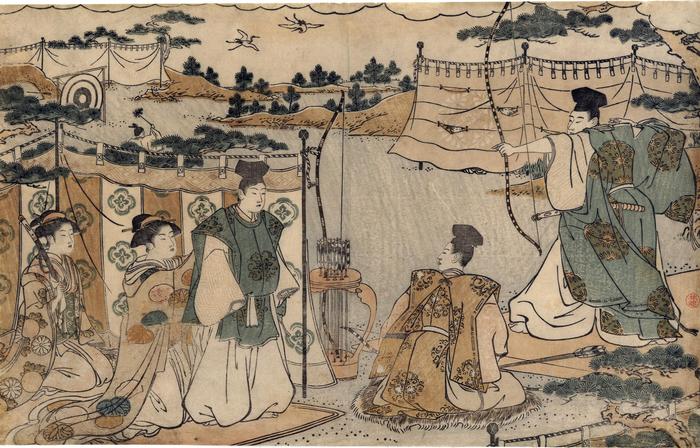Torii Kiyonaga (鳥居清長) (artist 1752 – 1815)
First Archery of the New Year (Yumi hajime - 弓はじめ) from the album Saishiki mitsu no asa (彩色美津朝) or 'Colors of the Triple Dawn'
1787
14.75 in x 9.25 in (Overall dimensions) Japanese color woodblock print
Museum of Fine Arts, Boston - for near perfect colors
New York Public Library
Museum of Fine Arts, Boston - key block impression
Art Institute of Chicago This print has the seal of the Hayashi Tadamasa (林忠正) collection in red along the lower right side. Scholten Japanese Art wrote of this man in reference to a Shigemasa print:
The small round seal in the lower left corner is that of the enormously influential art dealer, Tadamasa Hayashi (1853-1906). In his mid-twenties, Hayashi traveled to Paris in 1878 to work as a translator for a corporation managing the Japanese contributions to the Paris Exposition Universelle. At the conclusion of the exhibition, he stayed on to sell off the remaining stock while working for several trading companies and as an assistant to the collector and dealer, Wakai Kenzaburo (1834-1908). In 1884 they established a partnership, the Wakai-Hayashi company. Wen Wakai retired in 1886, Hayashi established the business in his own name. While Hayashi built up the retail side of the business in Paris, his wife, Satoko, remained in Tokyo and employed up to five other specialists (with notoriously high standards), to seek out the best prints for his thriving business in Paris. It was Satoko who suggested that they seal all of the works they handled. It has been estimated that some 160,000 Japanese prints and 10,000 illustrated books passed through Hayashi's hands into Western collections. The Hayashi seal is generally regarded as a reliable indicator of authenticity and quality and most of the great early collections of ukiyo-e were assembled with the help of Hayashi's expertise. In 1913, Hayashi's collection of Western prints and paintings was sold by his family in New York by the American Art Association (see cat. no. 10 & 18). In a foreword to the auction, the academic painter Raphaël Collin (1850-1916) described the monthly 'Diner Japonais' which was founded by another famous Paris-based dealer, Siegfried Bing (1838-1905; an important figure in the development of Art Nouveau), where Hayashi, "steeped in art to his very soul," would nurture their passion for Japanese art with "indefatigable patience and charming good nature."Tadamasa had dealings with Monet and is said to have assisted the Goncourt brothers in their research on Utamaro by translating Japanese texts.
The publisher was Nishimura Yohachi.
****
The Museum of Fine Arts, Boston notes that the signature to this series, Gakō Torii Kiyonaga (鳥居清長), appears on the last page.
****
The Fitzwilliam Museum has a print by Shinsai on this basic theme. Their curatorial notes state: "Indoor archery was a very popular pastime in Edo during the first half of the 19th Century. It was commonly enjoyed in shooting galleries that were commercially run in amusement quarters and in some major temple or shrine compounds. Young girls were hired as helpers, and inevitably prostitution was quietly practiced in some places. Yumi hajime (the initial archery shoot) had grown out of the samurai custom of practicing archery on the seventh day of January or at the opening of a new archery field. Archery galleries for the public probably adopted a similar custom, taking the opportunity to charge more for their dressed-up girls."
****
There is another copy of this print in the collection of the National Diet Library in Tokyo.
****
Illustrated in color in Ukiyo-e Hakka: Kiyonaga (浮世絵八華: 清長), vol 2, p. 112.
Nishimuraya Yohachi (西村屋与八) (publisher)
picture book (ehon - 絵本) (genre)
